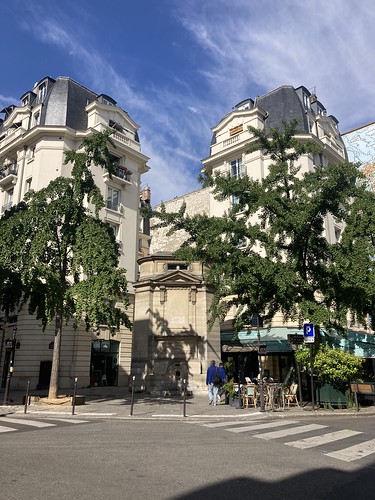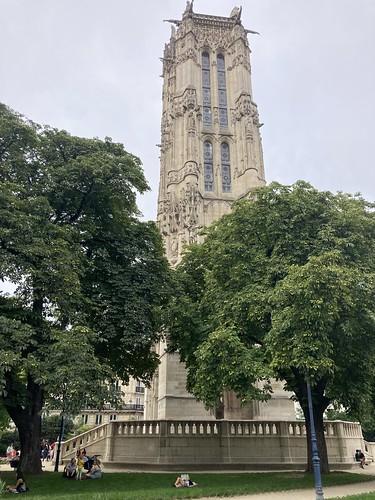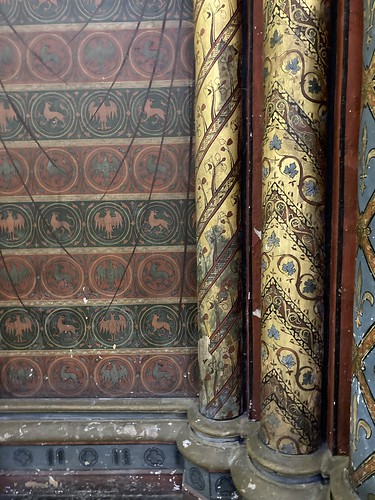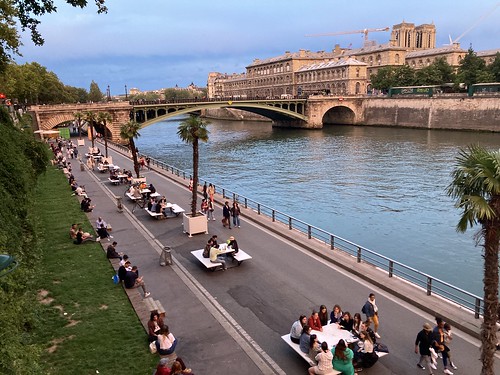Paris–August 8
We began the day with the practical task of doing laundry, which, not surprisingly, turned into a memorable adventure. Morning sunshine reflected from the recently cleaned old buildings turned routine urban activities into paintings.
Ancient architectural monuments adorned the way to the laundromat up the block.
Apartment buildings appeared as architectural marvels.
Across the street from the laundromat was the Andre Bresson museum of photography, where we stopped to buy a small collection of his work for a friend back home.
During the 40 minute dryer cycle, we wandered further up the Rue des Archives to a neighborhood park–the Square du Temple Elie Wiesel–surrounded by art-nouveau residences. Created in 1857, it was recently renamed in honor of the Holocaust-survivor author and activist.
Both botanical garden and wildlife refuge, it was enlivened with a variety of water features–a pond, waterfall, drinking fountains–
and a contemporary playground already full of children.
We collected our clean clothes and got a recommendation from our lively landlady for lunch at a “special” nearby restaurant called “Camille.”
On the way back to the hotel for siesta we stopped at a clothing store full of stylish reasonably priced merchandise we resisted the impulse to buy.
At the corner of our hotel’s side street and the Rue des Archives, we encountered another reminder of horrific events in the neighborhood’s history.
In memory of the small children in this orphanage who were deported between 1942 and 1944 because they were born Jews, victims of the Nazi barbarity, with the complicity of the Nazi government. They were exterminated in the death camps.
Later in the afternoon, we dressed up to attend a concert on the Isle de Cite for which we’d bought tickets in the States. Taking an alternate route toward the river, we passed a stand-alone tower surrounded by a park. Google maps and wikipedia on the iphone informed us that this 171 foot edifice was “all that remains of the former 16th-century Church of Saint-Jacques-de-la-Boucherie (“Saint James of the butchers”), which was demolished in 1797, during the French Revolution, leaving only the tower.”
Crossing the Pont de Neuf, we saw the concert venue inside the Palais de Justice, itself is contained within the Conciergerie, a royal palace and prison built in the 14th century.
We lingered at overlooks of the river, delighted by the counterpoint of industrial boat traffic, runners and dancers:
Ticket holders were conducted through the courtroom complex of the Palais de Justice to the Sainte Chapelle, the royal chapel of the monarchy built between 1238 and 1248
The stone and wooden portions of the interior were painted in exquisite detail
but most of the structure was composed of vaulting stained glass.
The music lived up to the program’s title, “the voice of heaven.”
The acoustics generated by harmonic reverberations made the soprano’s solo voice frequently sound like a chorus.
Recrossing the bridge afterward, we returned to an earthly paradise where people without tickets enjoyed picnicking in the summer evening light
followed by yet another celestial performance.


















